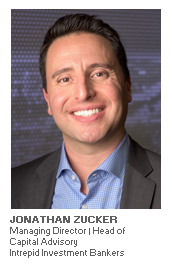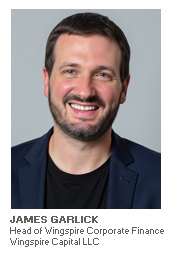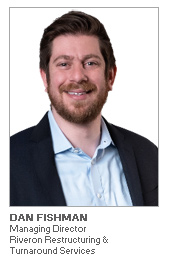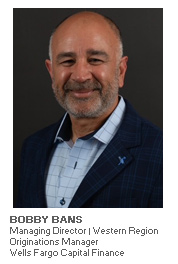
In this new feature, Charlie Perer sits with commercial finance industry participants to discuss the state of the ABL industry and general market dynamics. Through candid conversations with these industry leaders across lending, turnaround advisory, and capital raising, this feature offers valuable insights into their perspectives, strategies, and how they are positioning their businesses for success.
Participating in this discussion are:
- Jonathan Zucker, Managing Director and Head of Capital Advisory at Intrepid Investment Bankers
- James Garlick, Head of Corporate Finance at Wingspire Capital
- Bobby Bans, Managing Director and Western Region Originations Manager at Wells Fargo Capital Finance
- Dan Fishman, Managing Director at Riveron Restructuring & Turnaround Services
Charlie Perer: Please briefly introduce yourselves.

Jonathan Zucker: Thanks, Charlie. It is great to be a part of this group. As Head of Capital Advisory at Intrepid, I advise sponsor-backed and non-sponsored businesses on raising capital for growth, refinancings, acquisition, and dividend recapitalizations. My team and I raise capital across the capital structure from bank and non-bank sources and we specialize in deals with substantial complexity. There is often extreme urgency to our transactions, whether for good (i.e., acquisition that needs to close fast) or challenging (e.g., the bank wants out now) reasons.
Bobby Bans: I have spent most of my career in commercial lending both in cash flow and asset-based lending (ABL). Over the years, I have held functional roles in portfolio management, commercial banking relationship manager, underwriting and business development. Today, as the western region originations manager with Wells Fargo Capital Finance, I am proud to lead a team responsible for originating, structuring and executing ABL transactions in a twelve state region.

James Garlick: I am Co-founder and Head of Wingspire Corporate Finance. The business unit that I help lead is responsible for corporate transactions that range in size from $20 – $200 million, and where borrowers (or other lenders in the capital stack) would benefit from ABL Revolvers and Term Loans, First-Out Revolvers and Term Loans, Specialty Finance (or Lender Finance), as well as Healthcare Finance products.
Dan Fishman: Thanks for having me on the panel. I am a managing director with Riveron in our Restructuring & Turnaround group in Chicago. For about 10 years now I’ve been with Riveron, which acquired Conway MacKenzie. In my role, I work with companies, their stakeholders and other professionals—like those on this panel—through periods of distress, underperformance or transition.
Perer: How would you describe the current market environment through the lens of your own business?
Garlick: A combination of (i) highly competitive, (ii) a lot of uncertainty, and (iii) strong potential for growth.
Zucker: I am seeing a bifurcated market. We have well-performing businesses looking to access debt opportunistically, for example, to fund attractively valued acquisitions or dividend recaps. These include clients in less cyclical spaces such as utility services and healthcare. On the other hand, we see a lot of companies in more consumer discretionary businesses that are highly levered with bank debt and seeking an alternative solution.

Fishman: We’re in a unique and complex environment coming out of COVID and dealing with some of the fall-out from the pandemic. Interest rates remain high and, depending on who you speak with, could remain stubbornly high for an extended period. I think another key theme that we’re seeing in this environment is that the pandemic-fueled growth in many industries and across many businesses has subsided, yet companies have been slow to react to right-size the cost structure. Businesses that took on incremental debt to grow and expand to meet higher volumes during COVID are now facing the reality that the increase in demand may have been short lived. Private equity sponsors that have held portfolio companies through COVID with fatigued lenders are now facing pressure to exit in a higher interest rate and a stricter capital underwriting environment. Lastly, certain industries (retail and CPG for example) are also facing a direct threat from new Chinese tariffs. We’ve already seen US-based companies exit their manufacturing operations in China for countries like Vietnam. This will undoubtedly have a disruptive impact on global supply chains.

Bans: Although 2024 was a challenging year given the broader economy, we were prepared and took it in stride. The overall amount of market activity was slow over the first half of the year, as companies evaluated market trends, overall macro-economic dynamics and the ongoing uncertainty in the economy. We did see market activity tick up – particularly late in the year – and believe this increased momentum will continue into 2025.
Perer: Entering Q1 2025, where is deal flow both in terms of quality and quantity compared to this time last year?
Bans: With unprecedented levels of capital available, we believe 2025 will see significantly higher M&A activity resulting in higher financing volume. We saw transaction volume increase in the second half of 2024 with middle-market companies and private equity firms accelerating buy and sell side activity.
Garlick: Deal flow has been meaningfully better, both in terms of quality and volume, entering Q1 2025 compared to Q1 2024 and it’s not comparable for Wingspire.
Zucker: I would say it is slightly higher in both regards. Entering Q1 2024, it felt like many companies were sitting on the sidelines due to various factors that have since been addressed in one way or another, including election uncertainty and the rate environment. Unless they were being forced to transact, business owners were largely sitting tight. Now, with generational issues on the family-owned business side, and the DPI needs of private equity, among other factors, it seems like more folks are looking to make some sort of transactions happen in 2025.
Fishman: Deal flow picked up for our group in the back half of last year and continues to remain strong heading into Q1 2025. A big driver of this is that it seems that credit markets have tightened, requiring businesses and their stakeholders to address the underlying causes of underperformance rather than solely implement a capital structure solution. I’d also add that our interim management mandates (interim CFO, CEO, etc.) have picked up from this time last year, which could be viewed as a leading indicator of increased activity across the broader restructuring industry. Everyone is looking for management talent right now, both interim and permanent, especially those businesses in the middle market. We are helping businesses execute strategic objectives including top line or gross margin enhancement (looking at the pricing and customer mix), cost takeout and business rightsizing, and shedding non-core operations to help restore profitability and cash flow. We are seeing an increase in calls from lenders (both banks and private credit) to understand options and strategic alternatives as pre-COVID and COVID credits reach their maturities.
Perer: Can you compare and contrast the 2024 credit environment to where we are starting 2025?
Zucker: Based on our live mandates, I would say we are starting 2025 with a more constructive credit environment. Spreads have tightened, leverage availability on the cash flow lending side is up, and we are seeing ABL players push the boundaries on structure.
Garlick: There are a lot of similarities when comparing the 2H 2024 to now, however, the 1H 2024 to now is different. For Wingspire, the biggest difference is the increase in deal flow. Generally speaking, ABL is a transactional product, particularly for the non-bank ABL market. And when deal flow slows down like we saw during the 1H 2024, a ‘feeding frenzy’, or as others like to put it, ‘a race to the bottom’ on decent deals begins to take place by the bank and non-bank ABL markets. In contrast from then to now, the deal flow these past several months has been robust, and we are winning several stronger credits on terms and structure that we were not seeing during the 1H 2024.
Bans: I believe we saw the markets normalize in 2024, including a trend towards credit discipline. As we kick off 2025, I feel a sense of optimism in the markets and a focus on returning to growth.
Fishman: From my viewpoint as a turnaround consultant, the credit markets continue to tighten year over year. There are still pockets of liquidity available, but it’s much more difficult to locate and requires a robust and extended process. Deals that are getting funded have a clear and executable turnaround plan in place, are in a favored industry, and often require some owner equity or equity-like instrument in the capital structure to help get a deal over the finish line.
Perer: How do any lessons learned inform your decision making starting 2025?
Zucker: While the market is constructive for borrowers, the level of diligence – internal and third-party –and overall scrutiny from lenders remains very high. Therefore, going to market with as accurate a package (CIM, projection model, A/R and A/P agings, and fixed asset details) as possible is critical to maintain credibility throughout the process and avoid a broken deal. We are increasingly front-loading work, including sell-side Quality of Earnings and/or asset valuations prior to market launch, that historically had been reserved for confirmatory diligence once under exclusivity with a lender.
Garlick: For me, some of the biggest lessons learned are: first, never take anything for granted, secondly, always understand that we cannot control, nor are we able to time the market or behaviors in the industry. And lastly, the leadership teams need to pay close attention to their employees, making sure they are all continuing to support each other while also continuing to work relentlessly to deliver on our promise to our customers. Because if we do all of that, then I can assure our teams that we will be successful.
Fishman: Each client engagement provides its own unique set of circumstances, which lends itself to a productive post-mortem. I think the biggest takeaway from this past year has been the importance to simultaneously march down parallel paths (turnaround, refinance, sell) earlier in the process to maximize value for all stakeholders involved. There is a lot of uncertainty in the overall economy, and the optionality to execute across multiple paths is critical to the success of distressed situations in this environment.
Bans: This is a dynamic industry, so we constantly apply ‘lessons learned’ in how we serve our customers and prospects. We believe that balance and experience – whether it’s industry sector knowledge, structuring acumen or market intelligence – is what resonates with our customers as we partner with them on financing opportunities. It’s also about making sure you are constantly present by calling, calling and more calling! For 2025, my team is focused on staying in front of our prospects and referral sources. Whether it’s a call, coffee meeting or lunch, it is so important to be top of mind with our referral sources.
Perer: Do you anticipate more new deal activity from the sponsor universe or bank transitions/exits?
Garlick: Sponsor activity. I believe where sponsors are with their funds, and with interest rates having stabilized, the banks and cash flow lenders should see an uptick in M&A. I hope that non-bank ABL will benefit as well, but my gut tells me the uptick in sponsor activity that we will end up seeing in 2025 will come from div/recaps less than M&A. But it would be great if we could be a large part of M&A as well if there is an uptick.
Zucker: Yes to both. We have heavily ramped up our efforts supporting financial sponsors who are increasingly outsourcing debt advisory so they can focus on deal origination and execution. This spans regular-way acquisition facilities to complex refinancings to structured junior capital solutions. On the bank transition side, we have seen a decrease in patience among banks regarding challenging credits; the special assets teams are busy and motivated to reduce exposure to non-compliant businesses. As a result, we expect to continue to see new deal activity from this channel.
Bans: We expect more activity from both because we have made significant investment hires in our Commercial Bank and in covering sponsors, and the increased activity in the market should be a tailwind to continue to expand our share.
Fishman: This is a great question. I hope this isn’t a cop-out, but my answer is “both,” but the sponsor activity is oftentimes tied to the broader lender activity. We’ve seen increased activity from sponsors to help get ahead of any potential liquidity issues or covenant issues, and help portfolio companies quickly and efficiently create detailed business plans to provide clearer insight into profitability, performance and liquidity, which in turn helps the sponsor make better informed decisions around capital requirements, lender negotiations, etc. We’ve also seen a sharp increase in our interim management engagements (for both distressed and non-distressed businesses), mainly from sponsor-backed businesses. This is directly related to the ongoing talent gap amongst executive level finance and accounting personnel in the middle market. On the lender side, we have seen an increase in calls to understand strategic options and exit opportunities as lenders face loan maturities and continued underperformance from their borrowers. Similar to the sponsor community, lenders are trying to get ahead of any credit or liquidity concerns.
Perer: Is the narrative surrounding private credit rapidly taking bank market share true or over-stated?
Zucker: In our deal size sweet spot of $50 to $100 million, we tend to agree with this narrative. As I mentioned, we are usually under significant time pressure to close our transactions. Accordingly, even when a client may be a candidate for lower interest rate bank financing, we often end up in the non-bank universe under the age-old mantra of “speed and certainty of closing.” This is particularly valid when we are arranging acquisition financing for financial sponsors operating on short exclusivity timelines. Private credit funds are sitting on hundreds of billions in dry powder and are primarily loan-motivated, whereas banks may have different priorities at different times, including focusing on non-risk lines of business (i.e., deposits, currency hedging, and other ancillary services).
Garlick: Over-stated for asset-based lending (excluding the specialty/lender finance market). I would argue that the banks have been finding ways to take market share from the non-bank ABL lenders (more than non-bank ABLs taking market share from the bank ABL market), at least on larger transactions that have decent availability and are showing signs of turning around. We have too many examples of deals that we lost to a bank where we were left scratching our head and asking ourselves: “How are they able do that as a regulated institution again?”
Fishman: I think that this narrative was true during the past few years; however, it doesn’t appear to hold as much weight today. I’m also not sure you can paint a broad-brush response to this question. I think there are certain banks that are still aggressive in the market and certain private credit participants that have pulled back. It remains very much a case-by-case (or lending-institution-by-lending-institution) situation. We are seeing some national money center banks aggressively attacking the middle market, and we are seeing some private credit institutions become more conservative. All of this goes to support the need for a broad and wide process when raising capital in today’s environment.
Perer: Where will the market be five years from now given the amount of new private credit funds entering the market?
Garlick: I would love to hear the answer/opinion from so many different bank and non-bank leaders out there because there are so many paths that you could this response. From a non-bank perspective, I believe more banks will find ways to form joint ventures with the non-banks. Additionally, you will see more and more insurance companies and large, strategic asset managers make a bigger play in building or acquiring non-banks platforms. What’s uncertain is measuring the impact of AI within our industry, but I am confident that we would be naïve to believe that it won’t be implemented by several of us, someway somehow, over the next several years.
Fishman: Just like any industry that experiences rapid growth and a rush of new participants, I’m certain that there will be winners and losers within private credit. Overall, I do think that the industry will continue to grow, expand, and reinvent itself with new and unique products. Having dealt with distressed and liquidity challenged businesses for most of my career, I can tell you with great confidence that we will explore any and all options available to unlock incremental liquidity.
Zucker:The only certainty is that it will look a lot different! I anticipate more new entrants as well as more consolidation. We are seeing massive M&A already, with recent deals like Blue Owl’s acquisition of Atalaya and Blackstone’s announced, pending acquisition of HPS.
Continued on Page 2...